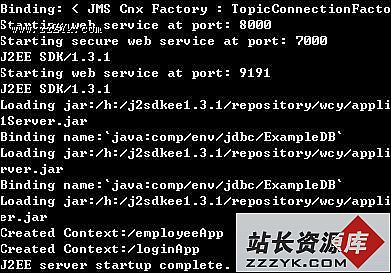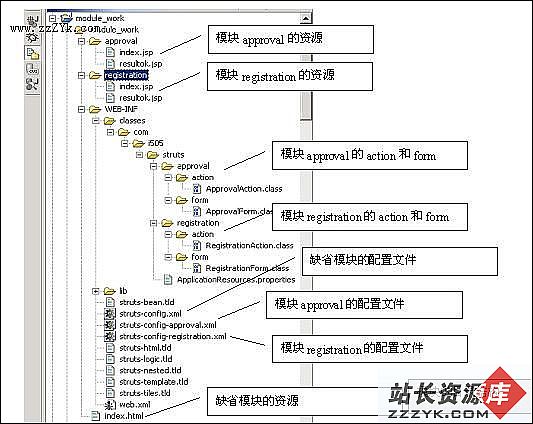当前位置:编程学习 > JSP >>
答案:By Scott Ferguson
Blueski编译
目录如下:
1 引论
2 范例的框架: Hello, World
3 Servlet 评论
4 展示留言本
5 留言本的模式
6 作为应用属性的留言本
7 留言本的逻辑
8 结论
1 引论
JSP的强大优势在于把一种应用的商务逻辑和它的介绍分离开来。用 Smalltalk的面向对象的术语来说, JSP鼓励MVC(model-view-controller)的web应用。JSP的classes 或 beans 是模型, JSP 是这个视图, 而Servlet是控制器。
这个例子是一个简单的留言本,包括用户登录和留言。它被作为Resin平台的示范:
--执行角色
--模型 A 留言本
--用于新用户的login.jsp
--用于已注册用户的add.jsp
--控制器 GuestJsp, 一个用来管理状态的servlet
2 样板的框架: Hello, World
GuestJsp servlet的框架把 "Hello, World" 这个字符串传给login.jsp页面。这个框架为留言本设立结构。具体细节将在下面补充。
这个例子被编译后可以浏览到:
http://localhost:8080/servlet/jsp.GuestJsp
你可以看到页面上有这样的显示: Hello, world
JSP模板是以Servlet的处理开始然后把处理结果传给JSP页进行格式化。
以下使用了一个Servlet2.1 ServletContext的特性 getRequestDispatcher()。
请求的调度器在服务器上让servlets直接向前传送并包括了任何可能的子请求。对SSI包含来说这是一个更灵活的取代做法。
在servlet文件中请求的调度器可以包含任何页面,servlet,或JSP的结果。 GuestJsp将使用dispatcher.forward()来将控制传给JSP页进行格式化。
GuestJsp.java: Skeleton package jsp.GuestJsp;
import java.io.*;
import java.util.*;
import javax.servlet.*;
import javax.servlet.http.*;
/**
* GuestJsp is a servlet controlling user
* interaction with the guest book.
*/
public class GuestJsp extends HttpServlet {
/**
* doGet handles GET requests
*/
public void doGet(HttpServletRequest req,
HttpServletResponse res)
throws ServletException, IOException
{
// Save the message in the request for login.jsp
req.setAttribute("message", "Hello, world");
// get the application object
ServletContext app = getServletContext();
// select login.jsp as the template
RequestDispatcher disp;
disp = app.getRequestDispatcher("login.jsp");
// forward the request to the template
disp.forward(req, res);
}
}
servlet和jsp页使用HttpRequest对象中的属性进行通信。skeleton在"message"属性中保存了"Hello, World"。
当login.jsp启动时,它将捕捉到该字符串并将其打印出来。
由于Resin的javascript能够读取扩充的Bean模型,它可以将request.getAttribute("message")转换成为
javascript的对应物 request.attribute.message。
login.jsp: Skeleton <%@ page language=javascript %>
<head>
<title><%= request.attribute.message %></title>
</head>
<body bgcolor='white'>
<h1><%= request.attribute.message %></h1>
</body>
3 Servlet的复习
对于来自于ASP或CGI背景并转向jsp的人来说,
Servlets代替CGI脚本体现了Java在动态类加载方面的优势。servlet就是一个Java类,
它对Servlet或HttpServlet进行了扩展并放置到适当的路径中。Resin将自动加载servlet并执行它。
url /servlet/classname将request提交给Servlet请求器。请求器会从doc/WEB-INF/classes自动加载Java类的类名
并试图执行Servlet的service方法。
Resin将定期检查类文件以判断是否被修改过。如果被修改过,则将用新的servlet取代旧的。
4 显示留言本
在基本框架已经运行后, 下一步是创建model。
5 留言本模型
留言本是很直接的,这里知识包含了一下API。它遵从Bean模型以简化javascript。
同样的API可以工作于HashMap, 基于文件,以及数据库应用。
JSP文件只能存取public方法。所以JSP文件无法创建一个新的留言本或者增加一个新用户。
这是GuestJsp servlet的责任。
jsp.Guest.java API package jsp;
public class Guest {
Guest();
public String getName();
public String getComment();
}
Resin的javascript能读取Bean模型。所以使用javascript的JSP页面可以存取getName()和getComment()
作为属性。例如,你可以简化使用guest.name和guest.comment。
jsp.GuestBook.java API package jsp;
public class GuestBook {
GuestBook();
void addGuest(String name, String comment);
public Iterator iterator();
}
Resin的javascript同样可以读取iterator()调用,所以你可以使用javascript用于 ... 任何一个来取得用户:
for (var guest in guestBook) {
...
}
GuestBook作为application属性
为了使得例子保持简单,GuestJsp在application (ServletContext)中存取GuestBook。作为例子,
在application中保存数据是可以接受的,但对于完全成熟的应用,最好仅使用application将数据放到其它地方。
jsp.GuestJsp.java // get the application object
ServletContext app = getServletContext();
GuestBook guestBook;
// The guestBook is stored in the application
synchronized (app) {
guestBook = (GuestBook) app.getAttribute("guest_book");
// If it doesn't exist, create it.
if (guestBook == null) {
guestBook = new GuestBook();
guestBook.addGuest("Harry Potter", "Griffindor rules");
guestBook.addGuest("Draco Malfoy", "Slytherin rules");
app.setAttribute("guest_book", guestBook);
}
}
RequestDispatcher disp;
disp = app.getRequestDispatcher("login.jsp");
// synchronize the Application so the JSP file
// doesn't need to worry about threading
synchronized (app) {
disp.forward(req, res);
}
JSP文件本身是简单的。它从application获取留言本并在表中显示内容。通常,
application对象需要同步,因为一些客户端可能同时浏同一页面。
GuestJsp在jsp文件被调用之前小心处理了同步情况。
login.jsp: Display Guest Book <%@ page language=javascript %>
<head>
<title>Hogwarts Guest Book</title>
</head>
<body bgcolor='white'>
<h1>Hogwarts Guest Book</h1>
<table>
<tr><td width='25%'><em>Name</em><td><em>Comment</em>
<%
var guestBook = application.attribute.guest_book
for (var guest in guestBook) {
out.writeln("<tr><td>" + guest.name + "<td>" + guest.comment);
}
%>
</table>
</body>
Hogwarts Guest Book
Name Comment
Harry Potter Griffindor Rules
Draco Malfoy Slytherin Rules
6 留言本的规则(logic)--作为应用属性的留言本
留言本的规则是很简单的。如果用户没有登录,他会看到一个提示和登录表。
登录后他会看到提示并在一个表中加入留言。 login.jsp给出了登录的页面,add.jsp给出了
增加流言的页面。
GuestJsp在session变量中保存了规则信息。
执行'login'来登录或 'add'来增加留言。 其中
name: 用户名
password: 口令
comment:留言
7 留言本规则 ...
// name from the session
String sessionName = session.getValue("name");
// action from the forms
String action = request.getParameter("action");
// name from the login.jsp form
String userName = request.getParameter("name");
// password from the login.jsp form
String password = request.getParameter("password");
// comment from the add.jsp form
String comment = request.getParameter("comment");
// login stores the user in the session
if (action != null && action.equals("login") &&
userName != null &&
password != null && password.equals("quidditch")) {
session.putValue("name", userName);
}
// adds a new guest
if (action != null && action.equals("add") &&
sessionName != null &&
comment != null) {
guestBook.addGuest(sessionName, comment);
}
String template;
// if not logged in, use login.jsp
if (session.getValue("name") == null)
template = "login.jsp";
// if logged in, use add.jsp
else
template = "add.jsp";
RequestDi
上一个:困扰JSP的一些问题
下一个:jsp与ejb通信
- 更多JSP疑问解答:
- jsp新手求指导,不要笑!
- 如何让一个form提取的值传递给多个jsp?
- DW中,新建的html页面能否有jsp或php代码?
- jsp 如何限制表单,实现只能填写特定的数据。
- jsp 和javabean结合的程序有问题
- 从数据库里取出的数据如何传递到另外的jsp页面中
- 你好,ext嵌入那个jsp页面,是不是还需要加上一些插件啊,不太懂,麻烦你了。
- JSP不能处理所有问题吗?还要来一大堆的TLD,TAG,XML。为JSP 非要 Servlet 不可吗?
- 光标离开时全角转半角在jsp中怎么实现
- jsp 页面 打开 pdf 文件 控制大小 和 工具栏 能发份源码么 谢啦
- jsp页面点保存按钮,运行缓慢,弹出对话框提示
- jsp刷新页面如何不闪屏
- jsp 与html 的交互问题?
- jsp小数显示问题 例如 我在oracle 数据库中查询出来的是 0.01 但是在jsp页面上就显示成 .01 没有前面的0
- jsp中日历控件





